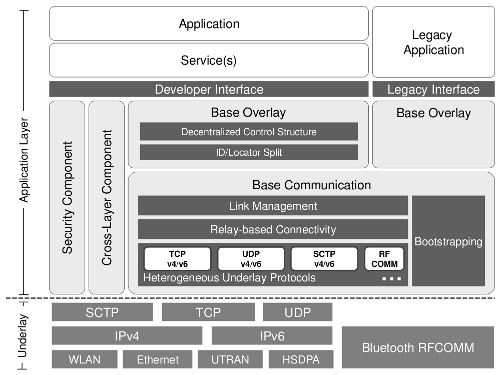| Version 4 (modified by , 17 years ago) ( diff ) |
|---|
Ariba Features
Ariba eases development and rapid prototyping of overlay-based services and applications. To this end, it provides mechanisms for creation and maintenance of overlay links across heterogeneous networks. Furthermore, it supports simulation and of Ariba-based services and applications without changing the code. The main features of Ariba include: 
- Node indentificators: Ariba provides a naming mechanism that uses consistent identificators instead of locators for specifying the target of a link.
- Requirement driven protocol selection: Ariba allows for specifying QoS- and security requirements for each link. Based on the requirements, Ariba transparently selects appropriate transport protocols (e.g., TCP, UDP) and security mechanisms (e.g., TLS, IPSec).
- Support for heterogeneity on layer 3: Ariba transparently establish connections between different layer 3 technologies (e.g., IPv4 and IPv6) and to private address spaces (e.g., due to NAT).
- Mobility: In case of locator changes due to handovers, Ariba will transparently reestablish connectivity without affecting services and applications.
- Multihoming: In case of multihomed nodes, Ariba transparently selects appropriate locators for link establishment and selects alternative locators in case of locator failures.
- Simulation support: Ariba-based applications can be evaluated using the Omnet++ Discrete Event Simulation System without changing the code.
Attachments (1)
- AribaArchitecture.png (51.4 KB ) - added by 15 years ago.
Download all attachments as: .zip
Note:
See TracWiki
for help on using the wiki.